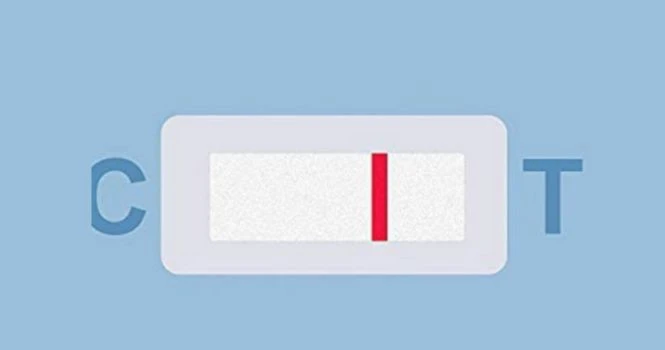Urine Pregnancy Tests at Home have become easy to use and women all over the world use it.
For More Detailed information Click on Urine Pregnancy Test Results Explained
Note: After you bring any Urine Pregnancy Test kit from the pharmacy, and after using urine to conduct the test, make sure you read the test only if there is colored Visible line in the “C” or Control Region. Only then it means the test kit is working fine.
Below are a few examples where you can’t see the colored visible line in the C or Control Region. This is Invalid test.
There are few instances when you come across the result, which you can’t interpret, as in the images below,

Here after the test procedure is done, we get this result.
The C or Control Part of the Test doesn’t have a colored line But the T or Test Part has a Colored visible Line.
Conclusion: If the colored band appears only in the T region but not in the C region. Then the Test is Invalid Test.
Next scenario which you might encounter is as shown below,

Here after the test procedure is done, we get this result.
The C or Control Part of the Test doesn’t have a colored line and the T or Test Part doesn’t have a colored line as well. There is no change in the Test strip before and after adding urine to the sample well.
Conclusion: If the color band does not appear on both the “C” Control and “T” Test region. Then the Test is Invalid Test.
What does an Invalid Pregnancy Test mean?
An invalid pregnancy test result indicates that the test has failed to provide a conclusive outcome, leaving the user uncertain about whether they are pregnant or not. This can occur for various reasons, such as using an expired test, not following the test instructions correctly, or reading the results too early or too late. In some cases, manufacturing errors or faulty tests can also contribute to invalid results. When faced with an invalid pregnancy test, it’s important to repeat the test with a new kit, ensuring that the test instructions are followed carefully.
If the issue persists, consulting a healthcare professional for further guidance is recommended.
What causes Invalid Pregnancy Test?
- Expired test: Using a pregnancy test that has passed its expiration date can lead to inaccurate or invalid results.
- Incorrect usage: Not following the test instructions correctly, such as not saturating the test strip sufficiently or holding the test incorrectly, may cause an invalid result.
- Reading the test too early: Checking the results before the recommended wait time may lead to an inconclusive outcome.
- Reading the test too late: Allowing the test to sit for too long before checking the results can cause the appearance of an evaporation line, which may be mistaken for an invalid result.
- Faulty test: Manufacturing errors or defects in the test components can lead to invalid results.
- Contaminated urine sample: The presence of blood, soap, or other contaminants in the urine sample may interfere with the test and cause an invalid result.
- Insufficient urine: Not applying enough urine to the test strip can lead to an inconclusive outcome.
- Diluted urine sample: Consuming large amounts of fluid before testing can dilute the urine, potentially affecting the test’s accuracy and leading to an invalid result.
- Incorrect storage: Storing the pregnancy test in extreme temperatures or humid conditions can compromise its accuracy.
- Damaged test: A test that has been physically damaged, such as a broken or cracked test strip, can result in an invalid outcome.
What to Do if You Get an Invalid Result?
If you’ve encountered an invalid pregnancy test result, it’s natural to feel uncertain and concerned about the next steps. Here are some practical guidelines to help you manage this situation:
- Don’t panic: Remember that invalid results can happen for various reasons, and it doesn’t necessarily indicate a problem with your pregnancy status. Stay calm and prepare to take appropriate follow-up actions.
- Re-read the instructions: Carefully review the test instructions to ensure you’ve followed them correctly. Check for any steps you might have missed or misunderstood.
- Retest with a new kit: Purchase a new pregnancy test, preferably from a different and reliable brand, and repeat the test. Make sure the test hasn’t expired, and follow the instructions precisely.
- Wait a few days: If you suspect that you might have tested too early, wait a few days before trying another test. This allows time for hCG levels to rise if you’re pregnant.
- Test with your first-morning urine: To ensure the most accurate results, use your first-morning urine when retesting. This is when hCG levels are typically the most concentrated.
- Consult your Doctor and resolve your issues at the earliest .














